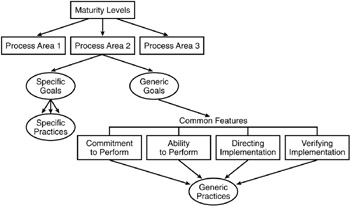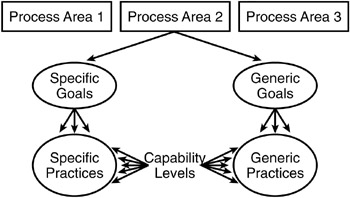Model Structure for the Continuous Representation
Model Structure for the Staged Representation
The CMMI is structured as follows :
-
Maturity Levels (staged representation) or Capability Levels (continuous representation)
-
Process Areas
-
Goals: Generic and Specific
-
Common Features
-
Practices: Generic and Specific
Exhibit 1 is taken from the CMMI staged representation that states that "maturity levels organize the process areas. Within the process areas are generic and specific goals, as well as generic and specific practices. Common features organize generic practices."
| |

| |
Exhibit 2 is taken from the CMMI continuous representation that states that "the specific goals organize specific practices and the generic goals organize generic practices. Each specific and generic practice corresponds to a capability level. Specific goals and specific practices apply to individual process areas."
| |

| |
Maturity Levels
A Maturity Level signifies the level of performance that can be expected from an organization. For example, Maturity Level 1 organizations have ad hoc processes, and Maturity Level 2 organizations have a basic project management system in place. There are five Maturity Levels.
Process Areas (PAs)
Each Maturity Level consists of several Process Areas. A Process Area is a group of practices or activities performed collectively to achieve a specific objective. Examples include Requirements Management at Maturity Level 2, Requirements Development at Maturity Level 3, and Quantitative Project Management at Maturity Level 4.
Relationship between Goals and Practices
Every Process Area has several goals that must be satisfied. Because goals are at a high level, each goal has practices associated with it. Practices are specific tasks that should be performed within the Process Area to achieve the goal. There are both generic and specific goals, as well as both generic and specific practices.
Goals
Each Process Area has several goals that need to be satisfied to satisfy the objectives of the PA. There are two types of goals:
-
Specific goals (SG): activities that relate to the specific PA under study
-
Generic goals (GG): goals that are common to multiple PAs throughout the model; they help determine whether the PA has been institutionalized
Practices
Practices are activities that must be performed to satisfy the goals for each PA. Each practice relates to only one goal. There are two types of practices:
-
Specific practices (SP) : relate to specific goals
-
Generic practices (GP) : are associated with the generic goals for institutionalization
For example, in the Project Planning PA, one of the practices is to write a Project Plan. Another is to estimate the number of people needed and to derive a schedule. Subpractices and examples are provided in the model to help explain the practices in more detail.
Common Features
Common Features simply group together the generic practices within a PA, according to the function that the practices fulfill. There are four Common Features:
-
Commitment to Perform (CO)
-
Ability to Perform (AB)
-
Directing Implementation (DI)
-
Verifying Implementation (VE)
Commitment to Perform (CO) is shown through senior management commitment and written policies. Ability to Perform (AB) is shown through training personnel in their duties , providing adequate resources and funding, assigning responsibility, planning the process, and establishing a tailored and defined process. Directing Implementation (DI) is demonstrated by managing configurations, identifying and involving relevant stakeholders, monitoring and controlling the process, and collecting improvement information. Verifying Implementation (VE) is demonstrated via objectively evaluating adherence (both process and product adherence to organizational policies, procedures, and standards) and by reviewing status with higher-level management. The continuous representation does not provide a mapping of practices to common features.
Other terms discussed throughout the CMMI include:
-
Typical Work Products: each process area gives examples of typical documents, deliverables, or other outputs produced within the process area.
-
Subpractices: lower-level practices that provide more information about the practice. For example, the Practice may be to write a project plan. The subpractice would offer information as to what should go into the project plan itself.
-
Discipline Amplifications: simple guidance offered to direct the user as to which discipline is more relevant for specific practices, or to offer some guidance in applying the PA to the discipline. The disciplines are Systems Engineering, Software Engineering, Supplier Sourcing, and Integrated Product and Process Development (IPPD).
-
Elaborations: more information and examples concerning generic practices.
-
References: refer the reader to related portions of the CMMI for more information.
-
Labels: each practice has a full name but is often documented and referred to by its shortened name or label. An example is in the continuous representation, Generic Practice 4.2. The label of this practice is Stabilize Subprocess Performance. The entire name of the practice is "Stabilize the performance of one or more subprocesses of the process to determine its ability to achieve the established quantitative quality and process performance objectives."
-
Resources: in the previous CMM for Software, resources generally referred to only people (e.g., staff, individuals, personnel). In the CMMI, resources can mean not only people, but also equipment, funds, facilities, and technology.
So, what do you really have to do? Are all of these elements as important as the next ? No. The CMMI gives us some guidance as to what is a required component, an expected component, and simply informative.
Required, Expected, and Informative Components
-
Goals are required to be achieved.
-
Practices are expected to be followed. Alternative practices that achieve the same concept can be substituted when the practice listed does not meet business objectives or fit the organization. Alternatives must be justified, documented, planned, implemented, and measured. The alternative substituted must be equal to the intent of the original practice. Do not try to substitute another practice because your organization is having trouble instituting the original practice.
-
Subpractices, elaborations, typical work products, and notes are informative and are used to help the reader understand the intent of the goals and practices, as well as how they can be achieved. Do not discount the subpractices. Sometimes, they are much more helpful and specific in understanding the activity than their associated practice.
EAN: 2147483647
Pages: 205